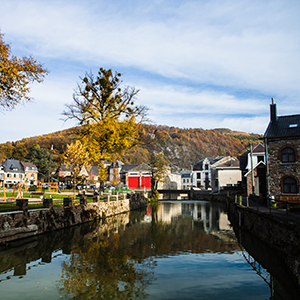Houx
Introduction
 Overlooked by the imposing Poilvache ruins, Houx is a charming little village set at the foot of the rock.
Overlooked by the imposing Poilvache ruins, Houx is a charming little village set at the foot of the rock.
It has grown along a road which runs parallel to the Meuse and extends along a few perpendicular lanes up to the rock face.
Separated from the main road only by a tree-lined green area, the village suffered greatly during the two World Wars.
It comprises dense housing with many adjoining homes. Most houses have been rebuilt using limestone.
There are however a few houses with masonry dating back to the 16th century, and the school and school-teacher's house were built c. 1889.
History and Heritage
The name Houx is of Germanic origin and means thorny wood or broom.
In 1830, Houx produced spelt, rye, oats, hay, potatoes and carrots.
In the orchards there were apple trees, pear trees and plum trees.
There were vast numbers of trees covering one-third of the village land; these were used for joinery and heating purposes.
The old forge at Houx was in operation at the beginning of the 14th century, as well as being operated towards the end of the 18th century by the Wilmets, who lived in Yvoir.
The forge was divided into two around 1840 and shut down when the Meuse was engineered around 1875.
Heritage
- The Chateau de Gaiffier.
- The Chateau de Blocqmont.
- The church
- Saint Barthélemy's Chapel
- Poilvache castle
- Champalle National Natural Reserve
- Le Clos des Mannoyes: on the hills above Houx, there is a vineyard where coins were also made in the 15th century. That is why this little white wine is simply called "Clos des Mannoyes". This wine is recognised as a French "Vin de France" wine by the oenological agronomy unit (Bordeaux fraud prevention office).



